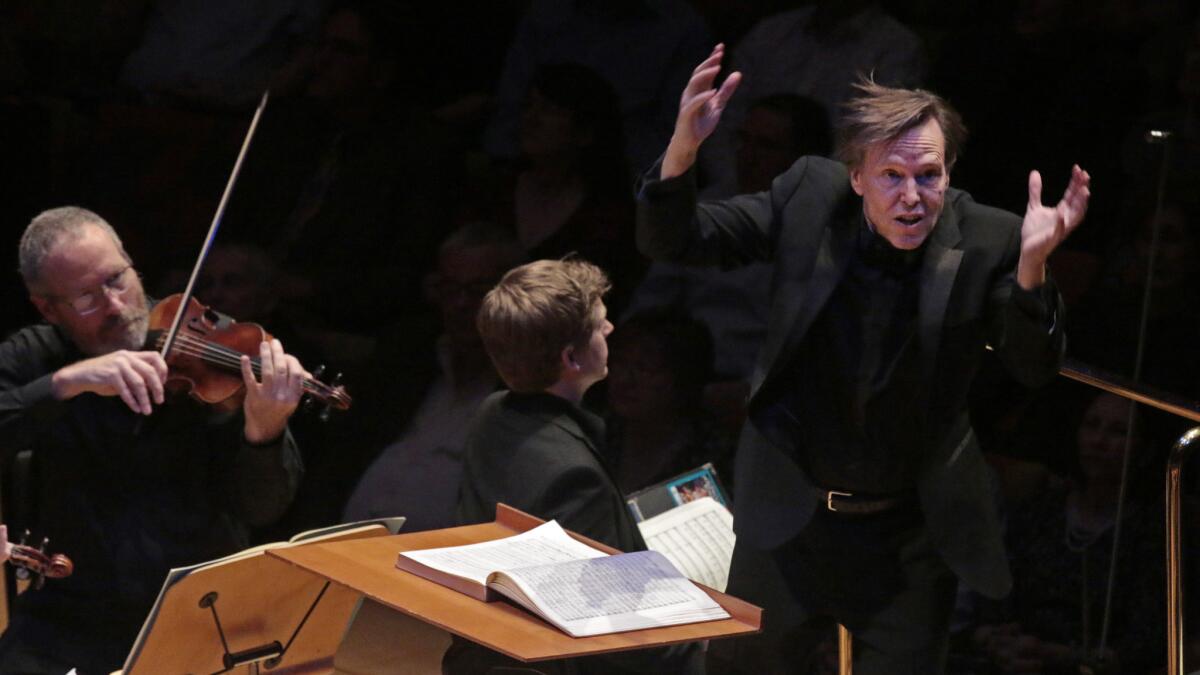Review: L.A. Master Chorale brings sense of community to ‘St. Matthew’ Passion

- Share via
Bach’s “St. Matthew” Passion, music’s most revered work, is not, at its deepest level, sacred music. Though a faithful retelling of Matthew’s Gospel through music and excellent for church use, the Passion is ultimately an exercise in community.
Musically, the “St. Matthew” conveys drama with theatrical vividness that reveals the death of Jesus as a human activity. But Bach’s greatest glory is in the ways his richest music moves beyond profound suffering and salvation.
A glowing final aria and chorus suggest the hope of a new society. One leaves a great performance understanding that when the world is wrong, our purpose is to change our collective minds to make it better.
ESSENTIAL ARTS & CULTURE NEWSLETTER >> Get great stories delivered to your inbox
The “St. Matthew” is also, of course, technically sophisticated music that requires the utmost dedication and ability from performers. The score is Bach delivering a message from on high. There are no sing-along “St. Matthew” offerings as there are for Handel’s “Messiah,” no pop-music Bach chorus covers as there are for the “Hallelujah” chorus.
Yet Sunday night at Walt Disney Concert Hall, the Los Angeles Master Chorale took the provocative step of performing the “St. Matthew” as participatory music.
Music director Grant Gershon invited an expert period-instrument orchestra, Musica Angelica, to provide historically informed instrumental support. But the soloists were all from the chorus.
The formal arias had mostly different singers. Given that there are many dramatic solo interjections (such as lines for Judas, Peter and Pilate as well as for priests and witnesses), nearly half the members of a chorus of around 50 had a moment in the limelight. The Master Chorale often does this for passions and oratorios, but the sheer intensity of the “St. Matthew” normally calls for specialists.
The result was that the drama itself was underplayed. The chorus members are capable singers, but few have either the experience or personalities of soloists. While there were far more individual voices than normal for a “Matthew” performance, there was less individuality.
On the other hand, the sense of community proved uncommonly persuasive.
The arias ask questions. What does Jesus feel? What’s going on? What does it mean? What should we do?
Soloists for whom coming forward wasn’t an everyday activity came forward, as though members of the public reading a prepared question to President Obama at a town hall meeting. They remained in the background, however, since they were stationed behind the orchestra. Most followed Gershon’s expressive conducting closely but rarely engaged with the orchestra or the audience.
Yet every single aria ended stronger than it began as confidence built. Over time — “Matthew” lasts more than three hours — a collective was created.
This was further emphasized by the fact that the Master Chorale as an entity is such a compelling body of singers. Sometimes Bach divides the chorus and the orchestra into pairs, and there is conflict. These were equal armies.
The orchestra, however, was often an alien element. The raw textures of some early instruments and their tunings require singers who also specialize in period practice techniques, not versatile modern choristers. Amusingly, some of the soloist bios included their Hollywood credits — this is Los Angeles, after all, and singers need work.
But where else are you likely to find so many performers who can go unaffectedly from “Glee” and “Smurfs 2” and “Godzilla” to the “St. Matthew”? Somehow that has to help.
Still, singers clashed with the orchestra. The soprano Elissa Johnston, the one member of the Master Chorale who is well-known as a soloist, was dramatically penetrating in her aria “Aus Liebe will mein Heiland Sterben” (For love my Saviour is willing to die). But she was accompanied by an intimidating solo Baroque flute and a pair of honking, tonally wayward bassoon-like oboes da caccia. That she remained on pitch was impressive.
As the Evangelist, Jon Lee Keenan offered a clarion tenor and commanding narrative style. Bass Chung Uk Lee’s Jesus was more plain-sung. Both performed from the front of the stage like traditional soloists, but Lee also returned to the chorus at the end for the exalted bass aria “Mache dich, mein Herze” (Make thyself clean, my heart).
In effect, then, that meant Jesus was burying himself. However peculiar, that could have been a potent concept, implying we are all Jesus. But for that to have meaning, a grander theatrical context would have been needed.
Gershon’s overall musical concept was for sweeping motion as a means to bring everyone together. There was no dawdling. The chorus sang with grandeur, and it was aided and made even grander when the Los Angeles Children’s Chorus joined in. The orchestra made perky sounds.
But the ultimate unity was found though focused phrasing and well-schooled forward momentum toward common purpose.
Twitter: @markswed
More to Read
The biggest entertainment stories
Get our big stories about Hollywood, film, television, music, arts, culture and more right in your inbox as soon as they publish.
You may occasionally receive promotional content from the Los Angeles Times.











